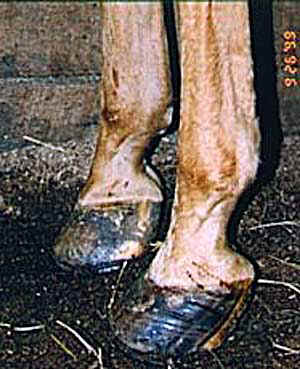
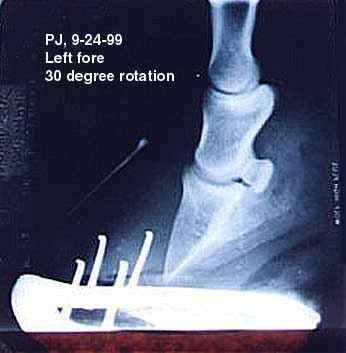
Treating Founder (Chronic Laminitis) without Horseshoes, Section 2
(Version with full-sized photos)
Here are some real life illustrations of these principles:
PJ, a mare rescued by the Tri-State Equine Adoption Rescue in Marydel, DE, originally had only 12 and 5 degree rotation. A couple of months after "therapeutic shoeing," her rotation progressed to 30 degree rotation in both fore feet.


The tip of the coffin bone stabbing straight down into the sole compromised the circulation of the sole corium enough that there was no more sole horn being grown. Please note: PJ's hairlines were actually sloped in the wrong direction! As the sole wears away and is not replaced with new growth, and only inflammation fluid accumulates, the sole becomes very soft. Soon, the coffin bone penetrates the sole:
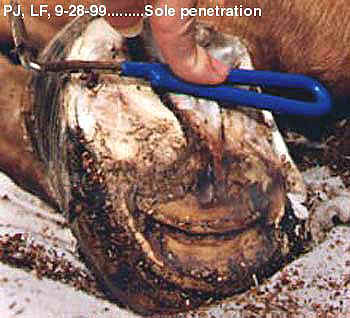
(PJ photos courtesy of Debbie Guelette.)
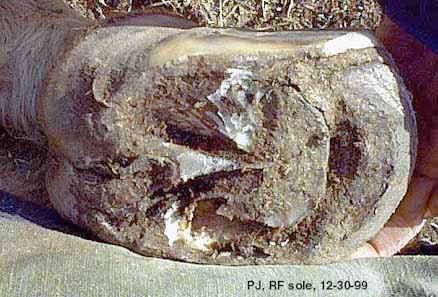
PJ three months later--sole beginning to grow back.
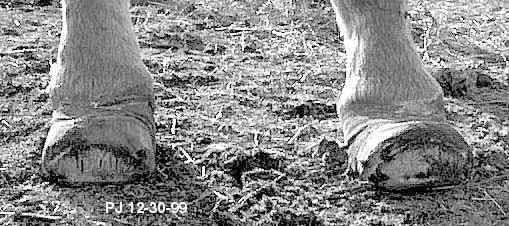
PJ three months later (Dec. 30, 1999)--note backed up toes,
tighter growth above "founder ridge."
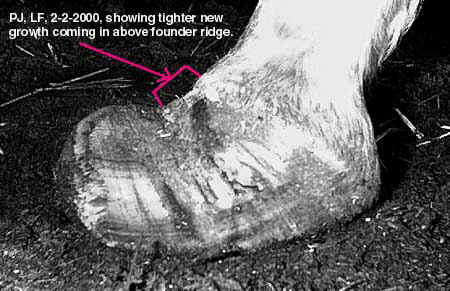
PJ, left fore, February 2, 2000, showing tighter growth
coming down above "founder ridge."
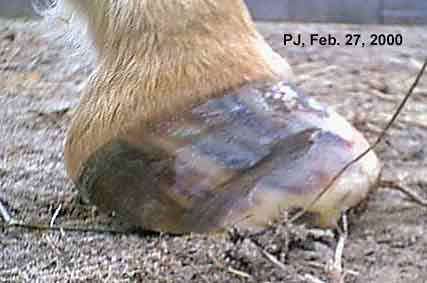
PJ, February 27, 2000--HUGE amounts of progress!
I do not have photos of the bottoms of her feet, though, which may still have had overlaid bars and protruding frogs, to some extent. I suspect this is the case because she was toe-walking, which is a sign of heel pain. Debbie did tell me that her bars and soles were lower than the walls, but tells me she had contracted tendons on both fores. In any event, she remained sore and was not up and moving around enough. Eventually, her owners had her put down in April, 2001. She also had other systemic problems, including her heart. Her original laminitis was the result of Lyme's Disease. She was a kind mare who was loved by everyone whose lives she touched, and is sadly missed.
Babe, had high heels and sole penetration in October of '98:
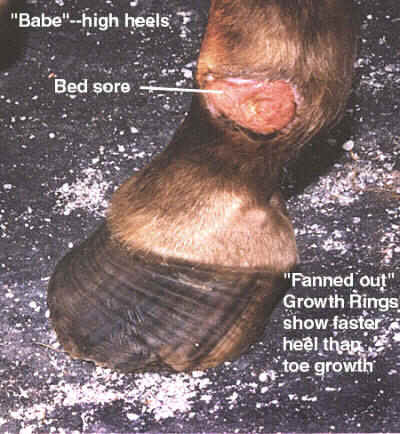
October, 1998. No hairline slope at all!
(Many bed sores on her--from being down all the time.)

October, 1998. Level hairlines = tipped coffin bone, pressure point on sole.

Babe had already started to fill in more sole due to better trimming,
but her heels and bars are still too high here.
Her soles have since filled in, and she had a healthy foal.
She went from being down all the time to walking and trotting.
Here are photographs of mare whose owner finally summoned the courage to get the coffin bone bottoms more ground-parallel, to the obvious relief of the pony. However, the toes still need to be backed up more in the August 8 photo.
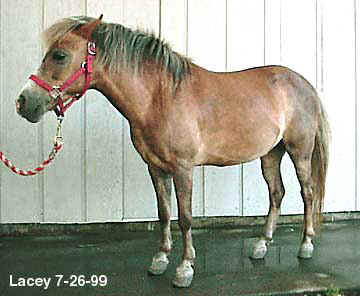
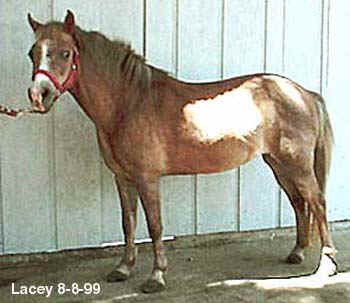
Lacey's heels were really high in the July 26 photo. The August 8 photo shows much more slope to the hairlines.
Please note: the August 8, 1999 photos of Lacey STILL are not a perfect trim. However, it is a step in the right direction. The front feet need the toes backed up.
Here are "Before" close-ups of Lacey:
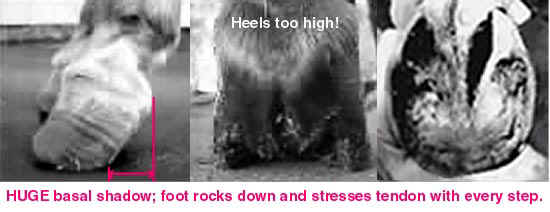
(Photos of Lacey, courtesy Kathy Monaghan)
Many farriers seem to believe that raising the heels will help laminitic horses by reducing the pull on the deep flexor tendon on the coffin bone. They are not taking into account the stress of high heels rocking down with every step being just as bad a stress. Plus high heels tip the bottom of the coffin bone, overstressing the laminae in the toe and often result in sole penetration.
Here is an extreme example showing how long-term high heels stress tendons:
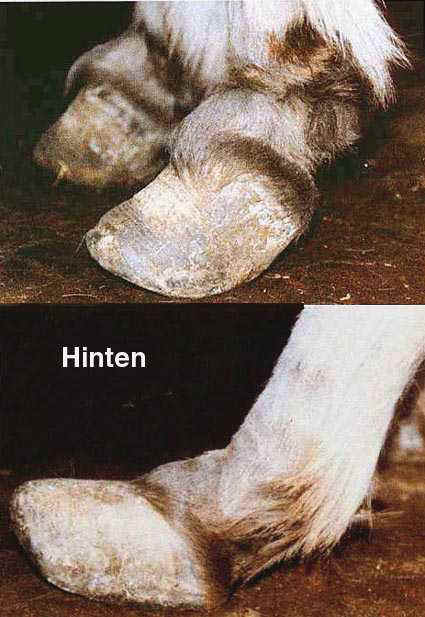
(Photos, courtesy of Dr. Hiltrud Strasser.)
This donkey was walking more on the backs of her high heels than on her soles.
Dr. Strasser completely rehabilitated her in 4 weeks....
and the first step was lowering her heels.
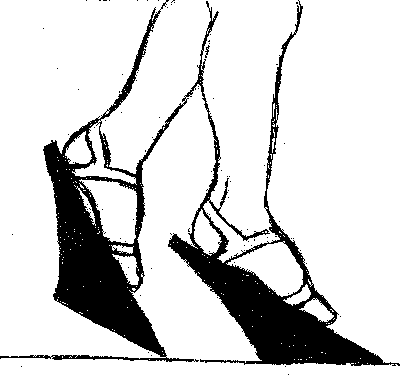
Although this is not directly equivalent to a horse--the real human equivalent is for us to be standing on just one toe--walking on something this high-heeled and under-slung will give a person a feeling for what high heels and having the base of the support out in front instead of further back and under the bony column must feel like to a horse...insecure, and very strained.
Another bad effect from high-heeled shoeing--the tip of the coffin bone is forced to remodel due to mechanical pressure. High-heeled shoeing for foundered horses is a popular idea, but one which can have destructive consequences. Compare Nova's X-rays from about a month after he foundered....and four and a half years later:
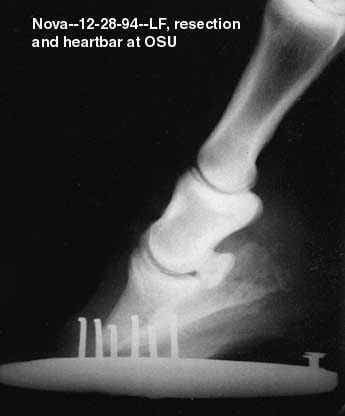
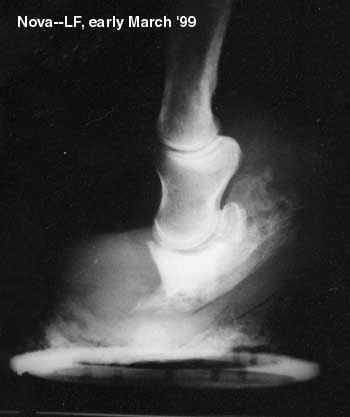
(Thanks to Denise McLain for permission to photograph Nova's X-rays.)
The conventional response to this deterioration is to jump to the conclusion that the coffin bone degeneration is caused by infection, rather than mechanical pressure, and to treat aggressively with antibiotics and the surgical debridement of the tip of the coffin bone. I question this in many cases. I believe it all can avoided in the first place by lowering the heels and backing up the toes.
Nova had been shod with a variety of orthopedic bar shoes, but the beginning of his deterioration was started in the first photo with the high heels not allowing the bottom of the coffin bone to be ground-parallel, and the toes not being backed up.
Back to home page--Table of Contents
Article in sections with "thumbnail" photos for
fastestdownloads:
1 9 17
2 10 18
3 11 19
4 12 20
5 13 21
6 14 22
7 15 23
8 16 24
NAVICULARArticle in sections with full-sized photos for print-outs:
1 9 17
2 10 18
3 11 19
4 12 20
5 13 21
6 14 22
7 15 23
8 16 24
NAVICULARTo Strasser case studies--thumbnail photos for
fasterdownloads
To Strasser case studies--large photosPlease sign my guest book! Photos of my pets My farm
Share Barefoot success stories on this page
Buy or sell used HORSE BOOTS Natural board Barn Listings
Click here to subscribe to naturalhorsetrim
(I moderate this listserv to weed out "fluff.")Send Email to Gretchen Fathauer, or call (740) 674-4492
Copyright by Gretchen Fathauer, 2015. All rights reserved.